10 Things We Learned From WWE Survivor Series 1992
Santa Claus likes Bret Hart...
You call this a Survivor Series? I mean, it's pretty hard to sneeze at an event that gives you Bret Hart vs. Shawn Michaels for the WWE Championship, the return of Mr. Perfect, and a tag team match with Ric Flair and Randy Savage on opposite sides, but this was a Survivor Series in name only. Really, it was just an extended Saturday Night's Main Event on a Wednesday, with one elimination match thrown in.
That's not the say that the 1992 Survivor Series was necessarily a bad show (it was still better than the bilge that was 1991), but the quaint thrill of the event had been sapped away. Not even holding the show in the Richfield Coliseum (the site of the awesome 1987 and 1988 shows) could restore the old flavour. It was simply a show - not a bad show, but a show.
The absence of Hulk Hogan, the veritable death of the classic Survivor Series format, the lack of Gorilla Monsoon on the call...this may have been one of the more jarring WWE pay-per-views of the time, a reminder that yesterday was, in more than one sense, a thing of the past. And the times ahead weren't going to be all that cosy, either.
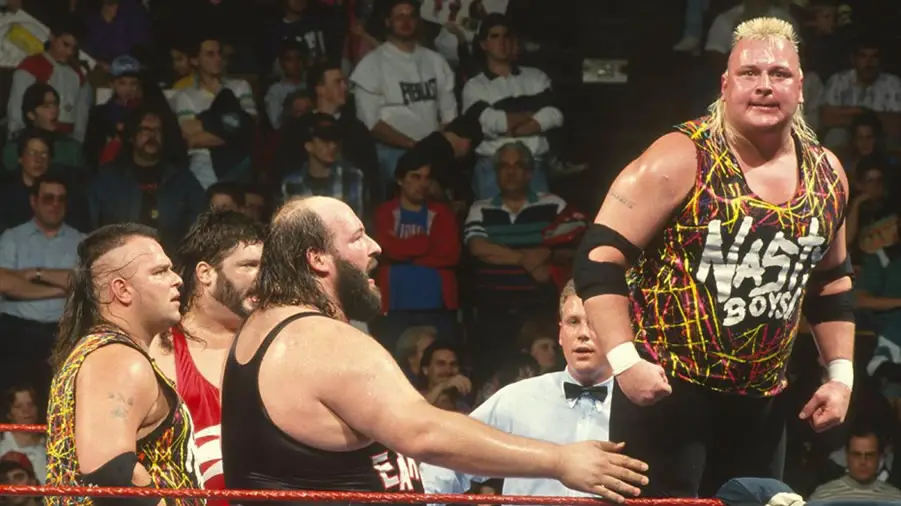 WWE
WWE
A grand total of 26 men wrestled on the Survivor Series 1992 main card (28 if you add in Crush and Repo Man in the dark match). By and far, that was the lowest total of Survivor Series participants to date, as 1987-90 boasted 40-50 wrestlers each, while the 1991 show had 32. A number as low as 26 would indicate cream of the crop only, but not exactly.
Ten out of the 32 wrestlers from one year earlier were no longer with the company (including Hogan, Roddy Piper, LOD, and others), and there was an influx of incoming, but not yet established, wrestlers on the roster in the fall of 1992. It's believed that the Survivor format was scrapped mostly due to the lack of a locked-in name-value talent at the time. Having just 26 guys on the show is a pretty good indicator of that.
 WWE
WWE
Earlier plans for the show called for an Intercontinental title match, pitting then-champion Davey Boy Smith against The Mountie. Smith, however, would drop the belt to Shawn Michaels at the Saturday Night's Main Event tapings in late October. The day before the title change, The Mountie actually quit WWE at the tapings in Springfield, IL, after losing an untelevised 30-second match to WWE Champion Bret Hart.
And Smith wasn't long for the company either. By mid-November, The British Bulldog was one of two wrestlers fired from the promotion for receiving shipments of human growth hormone from a pharmacy in the United Kingdom. Smith wrestled his last match of that run for the company one week before the title loss aired. As for the other wrestler that was fired...
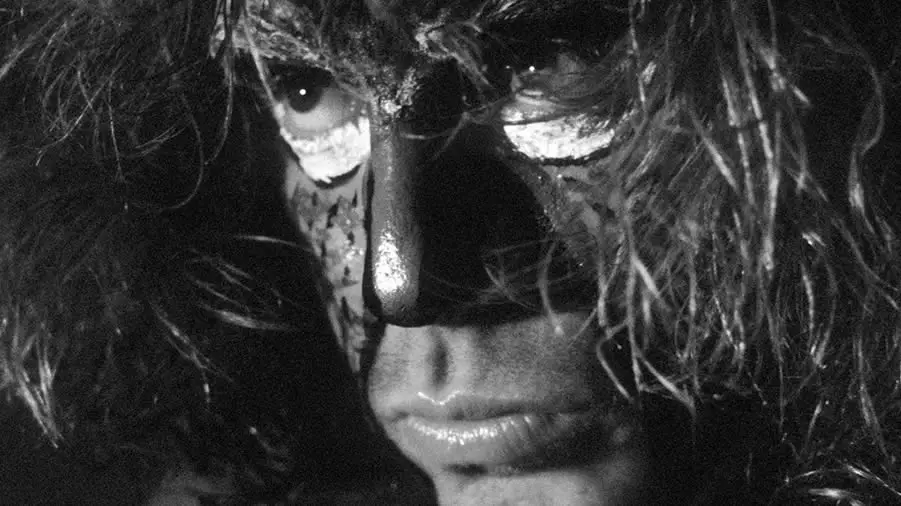 WWE
WWE
This leads us to the exodus of one Ultimate Warrior. Warrior was originally slated to form a dream team with Macho Man Randy Savage, to do battle against Ric Flair and Razor Ramon. Warrior was fired along with the Bulldog over the entire HGH deal, and would not return to the WWE fold for more than three years.
Filling in for Warrior would be a curious choice: Ric Flair's "executive consultant", Mr. Perfect. Perfect was hastily turned face with about nine days to go before Survivor Series, when Savage offered him the spot on Prime Time Wrestling. Bobby Heenan tried to refuse on Perfect's behalf, but Perfect, angry about being "spoken for", accepted. An irate Heenan smacked Perfect, who grabbed The Brain by his lapels, forced him to his knees, and dumped a pitcher of water on him to solidify his unexpected face turn.
 WWE
WWE
Flair had his own problems around the time of Survivor Series, which included a rather unusual injury sustained the previous month. During a house show match with The Ultimate Warrior toward the end of Flair's second World title reign, Flair began exhibiting issues with his balance following a turnbuckle-flip spot. He continued to wrestle through the title loss to Bret Hart, before getting a formal diagnosis.
The condition was known as paroxysmal position vertigo, a balance disorder that was caused by a chipped bone within Flair's ear. This led to his equilibrium being unsettled, causing the loss of balance. As a result of the issue, Flair would miss roughly a month of action, before returning to the road shortly before Survivor Series.
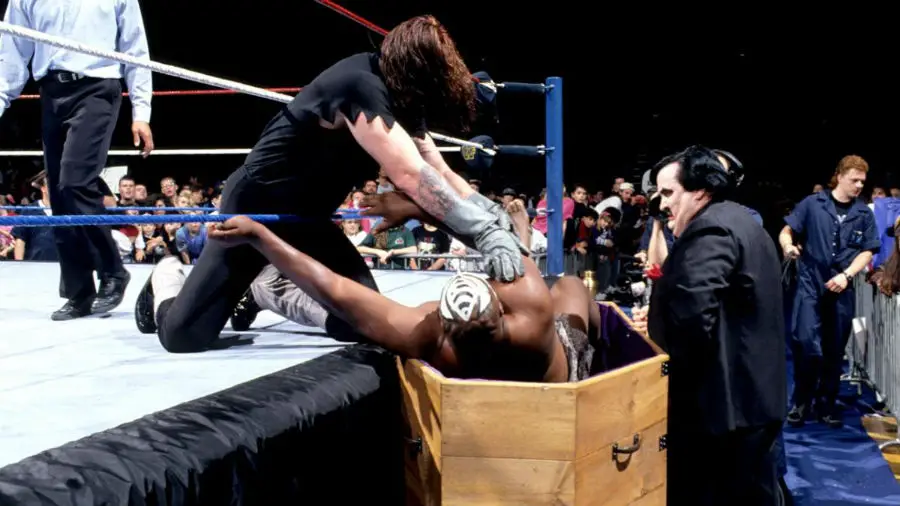 WWE
WWE
The semi-main would see The Undertaker put his feud with Kamala to rest (in a manner of speaking) by defeating the goliath in a casket match. After a brief five-and-a-half minutes of action, Undertaker rolled Kamala into the coffin, shut the lid, and proceeded to nail it shut. As a gimmick match, casket matches would prove to have lasting power, with one even taking place in 2018.
For wrestling buffs out there, this match marked the first time that a casket match was ever broadcast on either TV or pay-per-view. Previously, Undertaker had worked the match at house shows and in untelevised TV taping showings with the likes of Ultimate Warrior and Sid Justice. In fact, one such match with Warrior from August 1991 made it to WWE's Unreleased DVD set. But the match with Kamala was the world's first glimpse of just such a contest.
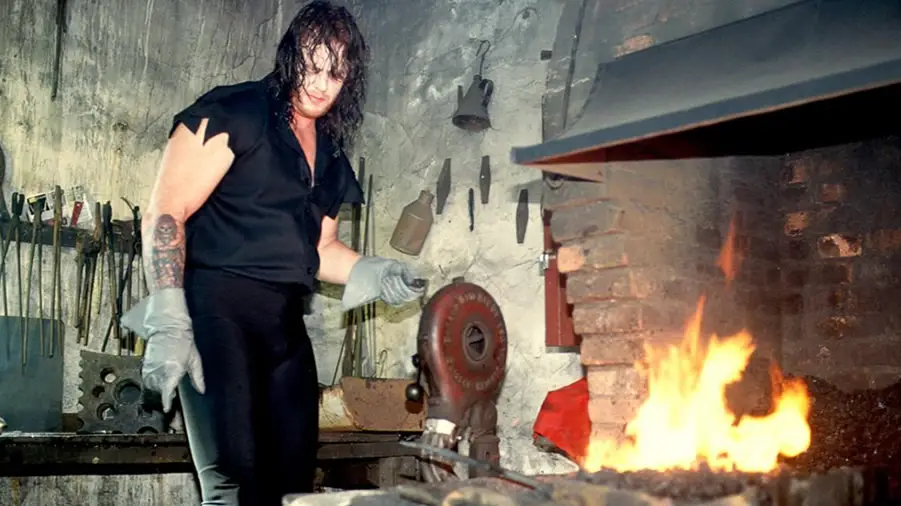 WWE
WWE
Few would've expected Undertaker vs. Kamala to be any sort of marathon match - just a simple brawl to both get a gimmick match over and give Undertaker a decisive win. The five-plus minute jaunt did have a practical purpose, however, as Undertaker was likely not at 100 per cent come the night of the pay-per-view.
The 19 October 1992 edition of The Wrestling Observer reported that Undertaker had been dealing with an arm injury, and was expected to miss a fair amount of time with bone chips in his elbow and shoulder. 'Taker took a few weeks off before returning to the fold, but was relegated to minute-long (or even less than that) house show wins over Nailz. At one juncture, Undertaker was thought to be in danger of missing the pay-per-view.
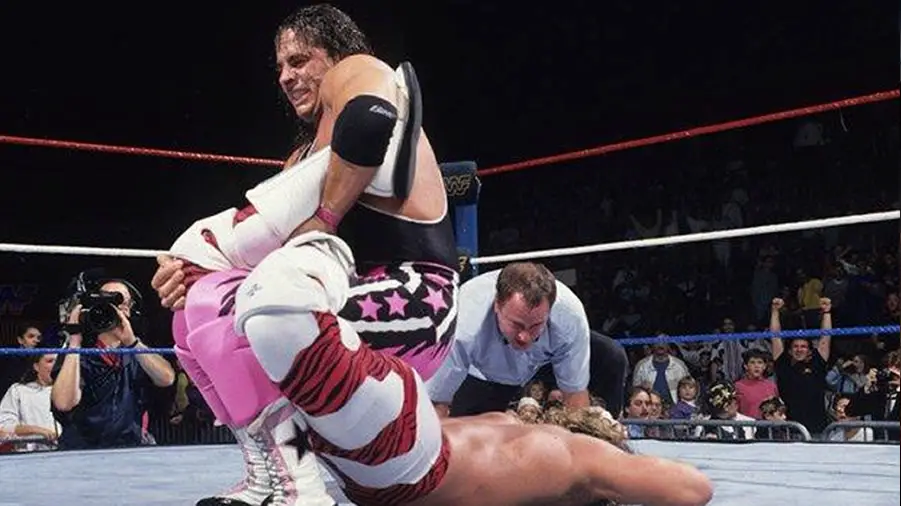 WWE
WWE
Easily, the best match of the evening was Bret Hart's successful WWE title defense over IC Champion Shawn Michaels, in what some could argue was their best singles match against each other (especially if you felt the Iron Man match was too plodding). If you ask Hart, the Survivor Series bout had a bit of a plod in its own right, but not enough to damage the match quality.
Hart would claim in his memoirs that the 27-minute match was paced slower than he would have liked, due to Michaels admitting that he wasn't exactly in the necessary ring shape to go that length at his usual pace. Can't say it hurt the match any; Hart and Michaels had an excellent bout for the gold, even if it wasn't as quick as The Hitman had intended it to be. Bret also said that Vince loved the match the way that it was, so there was no need for any griping.
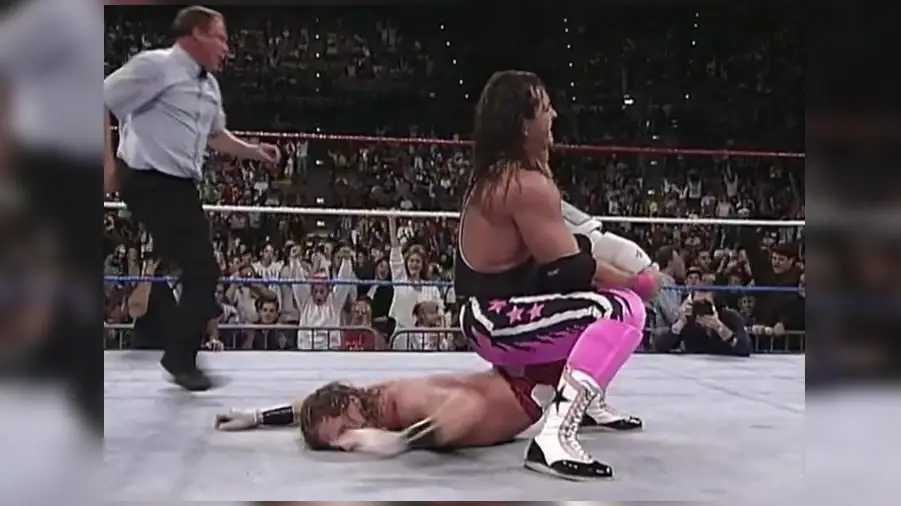 WWE
WWE
"Tapping out" wasn't a thing in WWE in 1992 - that wouldn't become a standard company gesture until Ken Shamrock contorted each of his foes like crazy straws five years later. Submissions back then were verbalized and were much rarer than they would eventually become. Only jobbers and undercarders submit with any regularity, with midcarders doing so sparingly.
When Hart forced Michaels to give up to the Sharpshooter at the end of the 1992 Survivor Series, it marked the first time a WWE would end on a submission. And just how rare a sight was that? Well, if you don't count the "Montreal Screwjob" as an official submission, the next WWE pay-per-view to end with somebody giving up was Unforgiven 2001, when Kurt Angle forced Steve Austin to tap to the ankle lock.
 WWE
WWE
In the opening entry, we spoke of the sadly reality that faced WWE at this point, that the rapidly-changing roster would see the loss of big names, the acquisition of less-stellar performers, and how the general state of the company reflected a turn for the worse. When you look at the 1992 Survivor Series, you see just how grim things truly were.
Of the 26 men that wrestled on the PPV card, 14 of them were no longer on the active roster at the time of Survivor Series 1993: Koko B. Ware, Big Boss Man, Nailz, Mr. Perfect, Ric Flair, Virgil, Brian Knobbs, Jerry Sags, Earthquake, Typhoon, Beau Beverly, Blake Beverly, Ted Dibiase, and Kamala. When more than half the wrestlers on a show are gone one year later, that's a wee bit alarming.
 WWE
WWE
As noted in our 1991 list, the buyrate of that show dropped 25 per cent from one year earlier, setting a new nadir for Survivor Series events. Sadly, 1992 would drop from even that, becoming the least-bought Big Four pay-per-view since the 1989 Royal Rumble, almost four years earlier. It sure seemed that things were going to get worse before they got any better.
The 1992 Survivor Series managed 250,000 buys, a 17 per cent drop from the previous year, and 38 per cent plummet from 1990. The 1989 Rumble was the only Big Four pay-per-view that did worse than the 1992 Survivor Series, and things would only continue to trend downward. Of the five pay-per-views in 1993, this Survivor Series tied one of them (SummerSlam), and did better than both King of the Ring and Survivor Series. So yeah, business was down.
That's not the say that the 1992 Survivor Series was necessarily a bad show (it was still better than the bilge that was 1991), but the quaint thrill of the event had been sapped away. Not even holding the show in the Richfield Coliseum (the site of the awesome 1987 and 1988 shows) could restore the old flavour. It was simply a show - not a bad show, but a show.
The absence of Hulk Hogan, the veritable death of the classic Survivor Series format, the lack of Gorilla Monsoon on the call...this may have been one of the more jarring WWE pay-per-views of the time, a reminder that yesterday was, in more than one sense, a thing of the past. And the times ahead weren't going to be all that cosy, either.
10. Thin On Names
 WWE
WWEA grand total of 26 men wrestled on the Survivor Series 1992 main card (28 if you add in Crush and Repo Man in the dark match). By and far, that was the lowest total of Survivor Series participants to date, as 1987-90 boasted 40-50 wrestlers each, while the 1991 show had 32. A number as low as 26 would indicate cream of the crop only, but not exactly.
Ten out of the 32 wrestlers from one year earlier were no longer with the company (including Hogan, Roddy Piper, LOD, and others), and there was an influx of incoming, but not yet established, wrestlers on the roster in the fall of 1992. It's believed that the Survivor format was scrapped mostly due to the lack of a locked-in name-value talent at the time. Having just 26 guys on the show is a pretty good indicator of that.
9. Double Elimination
 WWE
WWEEarlier plans for the show called for an Intercontinental title match, pitting then-champion Davey Boy Smith against The Mountie. Smith, however, would drop the belt to Shawn Michaels at the Saturday Night's Main Event tapings in late October. The day before the title change, The Mountie actually quit WWE at the tapings in Springfield, IL, after losing an untelevised 30-second match to WWE Champion Bret Hart.
And Smith wasn't long for the company either. By mid-November, The British Bulldog was one of two wrestlers fired from the promotion for receiving shipments of human growth hormone from a pharmacy in the United Kingdom. Smith wrestled his last match of that run for the company one week before the title loss aired. As for the other wrestler that was fired...
8. A Perfect Fill-In
 WWE
WWEThis leads us to the exodus of one Ultimate Warrior. Warrior was originally slated to form a dream team with Macho Man Randy Savage, to do battle against Ric Flair and Razor Ramon. Warrior was fired along with the Bulldog over the entire HGH deal, and would not return to the WWE fold for more than three years.
Filling in for Warrior would be a curious choice: Ric Flair's "executive consultant", Mr. Perfect. Perfect was hastily turned face with about nine days to go before Survivor Series, when Savage offered him the spot on Prime Time Wrestling. Bobby Heenan tried to refuse on Perfect's behalf, but Perfect, angry about being "spoken for", accepted. An irate Heenan smacked Perfect, who grabbed The Brain by his lapels, forced him to his knees, and dumped a pitcher of water on him to solidify his unexpected face turn.
7. Unbalanced Naitch
 WWE
WWEFlair had his own problems around the time of Survivor Series, which included a rather unusual injury sustained the previous month. During a house show match with The Ultimate Warrior toward the end of Flair's second World title reign, Flair began exhibiting issues with his balance following a turnbuckle-flip spot. He continued to wrestle through the title loss to Bret Hart, before getting a formal diagnosis.
The condition was known as paroxysmal position vertigo, a balance disorder that was caused by a chipped bone within Flair's ear. This led to his equilibrium being unsettled, causing the loss of balance. As a result of the issue, Flair would miss roughly a month of action, before returning to the road shortly before Survivor Series.
6. Burying The Competition
 WWE
WWEThe semi-main would see The Undertaker put his feud with Kamala to rest (in a manner of speaking) by defeating the goliath in a casket match. After a brief five-and-a-half minutes of action, Undertaker rolled Kamala into the coffin, shut the lid, and proceeded to nail it shut. As a gimmick match, casket matches would prove to have lasting power, with one even taking place in 2018.
For wrestling buffs out there, this match marked the first time that a casket match was ever broadcast on either TV or pay-per-view. Previously, Undertaker had worked the match at house shows and in untelevised TV taping showings with the likes of Ultimate Warrior and Sid Justice. In fact, one such match with Warrior from August 1991 made it to WWE's Unreleased DVD set. But the match with Kamala was the world's first glimpse of just such a contest.
5. Death Doesn't Take A Holiday
 WWE
WWEFew would've expected Undertaker vs. Kamala to be any sort of marathon match - just a simple brawl to both get a gimmick match over and give Undertaker a decisive win. The five-plus minute jaunt did have a practical purpose, however, as Undertaker was likely not at 100 per cent come the night of the pay-per-view.
The 19 October 1992 edition of The Wrestling Observer reported that Undertaker had been dealing with an arm injury, and was expected to miss a fair amount of time with bone chips in his elbow and shoulder. 'Taker took a few weeks off before returning to the fold, but was relegated to minute-long (or even less than that) house show wins over Nailz. At one juncture, Undertaker was thought to be in danger of missing the pay-per-view.
4. Slow It Down
 WWE
WWEEasily, the best match of the evening was Bret Hart's successful WWE title defense over IC Champion Shawn Michaels, in what some could argue was their best singles match against each other (especially if you felt the Iron Man match was too plodding). If you ask Hart, the Survivor Series bout had a bit of a plod in its own right, but not enough to damage the match quality.
Hart would claim in his memoirs that the 27-minute match was paced slower than he would have liked, due to Michaels admitting that he wasn't exactly in the necessary ring shape to go that length at his usual pace. Can't say it hurt the match any; Hart and Michaels had an excellent bout for the gold, even if it wasn't as quick as The Hitman had intended it to be. Bret also said that Vince loved the match the way that it was, so there was no need for any griping.
3. Milestones In Tapping
 WWE
WWE"Tapping out" wasn't a thing in WWE in 1992 - that wouldn't become a standard company gesture until Ken Shamrock contorted each of his foes like crazy straws five years later. Submissions back then were verbalized and were much rarer than they would eventually become. Only jobbers and undercarders submit with any regularity, with midcarders doing so sparingly.
When Hart forced Michaels to give up to the Sharpshooter at the end of the 1992 Survivor Series, it marked the first time a WWE would end on a submission. And just how rare a sight was that? Well, if you don't count the "Montreal Screwjob" as an official submission, the next WWE pay-per-view to end with somebody giving up was Unforgiven 2001, when Kurt Angle forced Steve Austin to tap to the ankle lock.
2. Thinning The Herd
 WWE
WWEIn the opening entry, we spoke of the sadly reality that faced WWE at this point, that the rapidly-changing roster would see the loss of big names, the acquisition of less-stellar performers, and how the general state of the company reflected a turn for the worse. When you look at the 1992 Survivor Series, you see just how grim things truly were.
Of the 26 men that wrestled on the PPV card, 14 of them were no longer on the active roster at the time of Survivor Series 1993: Koko B. Ware, Big Boss Man, Nailz, Mr. Perfect, Ric Flair, Virgil, Brian Knobbs, Jerry Sags, Earthquake, Typhoon, Beau Beverly, Blake Beverly, Ted Dibiase, and Kamala. When more than half the wrestlers on a show are gone one year later, that's a wee bit alarming.
1. Downward Spiral
 WWE
WWEAs noted in our 1991 list, the buyrate of that show dropped 25 per cent from one year earlier, setting a new nadir for Survivor Series events. Sadly, 1992 would drop from even that, becoming the least-bought Big Four pay-per-view since the 1989 Royal Rumble, almost four years earlier. It sure seemed that things were going to get worse before they got any better.
The 1992 Survivor Series managed 250,000 buys, a 17 per cent drop from the previous year, and 38 per cent plummet from 1990. The 1989 Rumble was the only Big Four pay-per-view that did worse than the 1992 Survivor Series, and things would only continue to trend downward. Of the five pay-per-views in 1993, this Survivor Series tied one of them (SummerSlam), and did better than both King of the Ring and Survivor Series. So yeah, business was down.
